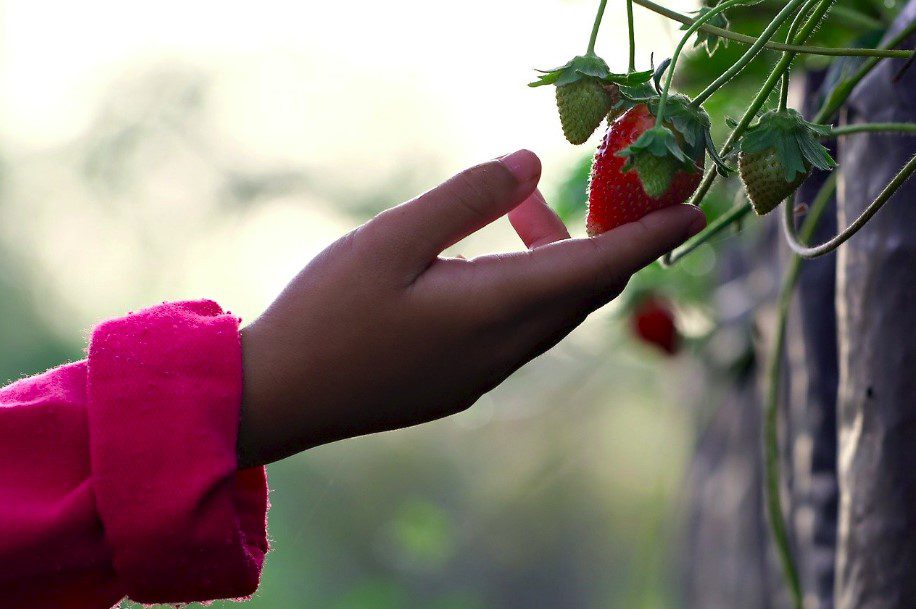From the moment children are born, they embark on a remarkable journey of discovery with the help of five senses. Sight, hearing, taste, smell, and touch form the building blocks of their understanding, perception, and interaction with the environment.
Collectively, the five senses empower children to engage with the world and exercise the FREEDOM to perceive, explore, and experience life to its fullest. They are chanced to connect with the environment, engage with others, and derive pleasure through these sensory encounters.
These senses not only provide a gateway to experiencing the world’s wonders but also play a profound role in shaping their cognitive, social, emotional, and physical development.
Harnessing the five senses in children involves providing opportunities and activities that stimulate and engage each one of them.
Here are the 5 senses and the strategies to help harness them in children:

1. Sight (Vision):
Sight, also known as vision, is one of the five senses. It refers to our ability to perceive and interpret visual stimuli using our eyes. Sight allows us to see the world, the people, and the environment around us.
Through the sense of sight, children unravel the visual tapestry that surrounds them, enabling them to recognize faces, objects, colors, movement and patterns.

Developing good visual acuity and depth perception supports their cognitive development, spatial awareness, and hand-eye coordination. Visual stimuli also contribute to language development as children observe and learn from their surroundings.
How to take advantage of Sight
- Encourage visual exploration by providing age-appropriate books, puzzles, and art materials.
- Take children on nature walks or visits to museums and encourage them to observe and describe what they see.
- Engage in activities that promote visual discrimination, such as sorting objects by color or shape.
2. Hearing (Audition):
Hearing refers to our ability to perceive and interpret sound. It involves the detection and processing of sound waves by our ears and the auditory system. Sound waves are vibrations that travel through the air or other mediums and are captured by our outer ears.
The sense of hearing forms a vital link to the world of sounds, shaping children’s language skills, communication abilities, and social interactions.

It plays a significant role in language development, as children learn to recognize and differentiate sounds, understand speech, and develop communication skills.
Hearing also contributes to social interaction, as children learn to respond to voices, follow instructions, and engage in conversations.
How to take advantage of hearing
- Read aloud to children and encourage them to listen to different genres of stories and books.
- Introduce children to a variety of music and encourage them to listen actively and identify different instruments or rhythms.
- Engage in conversations and encourage active listening skills by asking questions and responding attentively.
3. Taste (Gustation):
Taste refers to our ability to perceive and distinguish different flavors through our taste buds. It involves the detection and interpretation of chemical compounds present in food and beverages.
The surface of our tongue is covered with taste buds, which contain specialized sensory cells called taste receptors. These receptors are responsible for detecting five primary tastes: sweet, sour, salty, bitter, and umami (savory).
When we eat or drink, molecules from the food come into contact with our taste buds, stimulating the taste receptors. This triggers electrical signals that are transmitted to the brain through the gustatory nerve fibers. The brain processes these signals, allowing us to experience and differentiate various flavors.

Taste serves as a gateway to a world of flavors, textures, and nutritional exploration. Taste helps children explore and discern different flavors and textures of food. It allows them to develop preferences, learn about nutrition, and adapt to various dietary choices.
Taste also influences their sensory experiences and can evoke memories and emotions associated with specific tastes.
How to take advantage of taste
- Offer a wide range of foods with different flavors and textures to expand their taste experiences.
- Involve children in meal preparation and cooking activities, allowing them to explore ingredients and flavors.
- Encourage children to describe the tastes they experience and express their preferences.
4. Smell (Olfaction):
Smell, also known as olfaction, is one of the five senses that allows us to perceive and interpret different odors and scents in our environment. It involves the detection of airborne molecules that enter our nose and interact with specialized olfactory receptors located in the olfactory epithelium.
These receptors can distinguish thousands of different odor molecules. When we inhale, the molecules bind to the olfactory receptors, triggering electrical signals that are transmitted to the brain through the olfactory nerve pathways.
The brain then processes these signals and interprets them as specific smells. This lows us to identify and differentiate various scents.
Smell holds the power to evoke memories, trigger emotions, and ensure safety.

It enables children to detect and identify various odors in their environment. It plays a role in their safety by alerting them to potential dangers (e.g., smoke, spoiled food).
Smell is closely linked to taste, as it contributes to flavor perception. It also triggers memories and emotional responses, enhancing children’s overall sensory experiences.
How to take advantage of smell:
- Provide opportunities for children to smell different scents, such as flowers, herbs, or spices.
- Engage in sensory play activities like scented playdough, scented markers, or scented bubbles.
- Encourage children to describe and discuss the smells they encounter in their environment.
5. Touch (Tactile Sensation):
Touch describes our ability to perceive physical sensations through the skin and other sensory receptors in our body. It involves the detection of pressure, temperature, pain, and other tactile stimuli.
Our skin is equipped with different types of touch receptors, including mechanoreceptors, thermoreceptors, and nociceptors, which are specialized nerve endings that respond to specific stimuli.
When we come into contact with an object or experience a physical sensation, the appropriate touch receptors are activated. They generate electrical signals that travel through nerve pathways to the brain, where the signals are processed and interpreted. This allows us to perceive and make sense of tactile information.
The sense of touch is crucial for children’s physical and emotional development. Through touch, they explore textures, temperatures, and physical sensations, which helps develop their fine motor skills, hand-eye coordination, and body awareness.

Touch also promotes bonding and emotional connection, as children receive comfort, security, and affection through physical contact.
How to take advantage of touch:
- Provide a variety of tactile experiences, such as playing with sand, water, clay, or sensory bins filled with different materials.
- Encourage children to explore textures through touch and describe the sensations they feel.
- Engage in activities that involve fine motor skills, such as drawing, painting, or building with blocks.
Q & A on the Five Senses
Q1: What are the five senses?
A1: The five senses are sight (vision), hearing (audition), taste (gustation), smell (olfaction), and touch (tactile perception).
Q2: How does the sense of sight work?
A2: The sense of sight works through the eyes. Light enters the eye and passes through the cornea, then the lens focuses the light onto the retina at the back of the eye. The retina contains specialized cells called photoreceptors that convert light into electrical signals. These signals are then transmitted to the brain via the optic nerve, where they are interpreted as visual information.
Q3: What role does the sense of smell play in our daily lives?
A3: The sense of smell, or olfaction, plays a vital role in our daily lives. It helps us detect and identify various odors, influencing our perception of food, warning us of potential dangers, and triggering memories and emotions. Smell also contributes to our sense of taste, as many flavors are actually a combination of taste and smell.
Q4: How does the sense of taste work and what factors influence our perception of taste?
A4: The sense of taste, or gustation, involves taste buds located on the tongue and other parts of the mouth. Taste buds contain taste receptor cells that respond to different flavors: sweet, sour, salty, bitter, and umami (savory). When we eat or drink, molecules from the food stimulate these receptors, sending signals to the brain, which interprets them as specific tastes. Factors like temperature, texture, smell, and even personal preferences can influence our perception of taste.
Q5: What are the different types of touch receptors in our skin and how do they contribute to our sense of touch?
A5: Our skin contains various touch receptors that contribute to the sense of touch. They include mechanoreceptors, thermoreceptors, and nociceptors. Mechanoreceptors detect pressure, vibration, and tactile stimulation. Thermoreceptors respond to temperature changes, allowing us to sense hot or cold surfaces. Nociceptors are responsible for detecting pain and alerting us to potential tissue damage.
Q6: How does the sense of hearing work and how do our ears process sound waves?
A6: Hearing begins when sound waves enter the outer ear and travel through the ear canal. These reach the eardrum, causing it to vibrate. These vibrations are transmitted through a series of tiny bones in the middle ear called the ossicles (malleus, incus, and stapes). The last bone, the stapes, transfers the vibrations to the fluid-filled cochlea in the inner ear. Inside the cochlea, specialized hair cells convert the vibrations into electrical signals that are sent to the brain via the auditory nerve. The brain interprets these signals as sound.
Let Your Child Tap Into the Five senses
By embracing the power of sight, hearing, taste, smell, and touch, parents, caregivers, and educators can create a vibrant and stimulating environment that nurtures children’s sensory experiences.
Through engagement with the environment and sensory stimuli, children can build important skills, develop their perception and communication abilities, and foster a deeper understanding of the world around them.
It’s important to create a safe and supportive environment where children can freely explore their senses. Allow them to engage in sensory-rich activities and provide open-ended materials that encourage their curiosity and creativity.





Leave a Reply